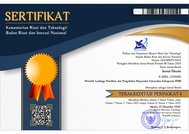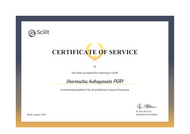Potensi desain gerobak wirausaha inklusif sebagai penunjang kemandirian down syndrome dengan pendekatan human centered-design
DOI:
https://doi.org/10.30998/jd.v13i1.40Keywords:
Down Syndrome, Human Centered Design, Kewirausahaan, Mebel Inklusif, Design Thinking, AntropometriAbstract
Penyandang Down Syndrome (DS) di Indonesia masih menghadapi eksklusi sosial dan ekonomi, meskipun potensi mereka untuk hidup mandiri dan berwirausaha semakin diakui. Penelitian desain inklusif selama ini banyak berfokus pada furnitur edukasi untuk anak-anak dengan DS, namun minim solusi fungsional bagi dewasa muda penyandang DS (18-35 tahun) yang terlibat dalam kegiatan vokasional. Penelitian ini mengisi celah tersebut melalui perancangan gerobak wirausaha inklusif yang mendukung kemandirian ekonomi mereka. Pendekatan metode campuran digunakan, menggabungkan pengukuran antropometri (n = 18) dan wawancara mendalam serta observasi partisipatif dengan penyandang DS dan pendamping. Data dianalisis secara triangulatif, mengintegrasikan standar ergonomi (persentil ke-5) dengan kebutuhan psikososial, lalu disintesis melalui prinsip Human-Centered Design (HCD) dan kerangka Design Thinking (Emphatize hingga Test). Hasilnya Adalah dua tipe gerobak – Cake & Cookies dan Art & Craft – masing-masing dengan enam alternatif desain yang mempertimbangkan ergonomi, keamanan, aksesibilitas, dan keterlibatan emosional. Penelitian ini memberikan kontribusi orisinal pada desain inklusif dan wirausaha disabilitas, sekaligus menjadi wujud operasional dari hak penyandang disabilitas atas pekerjaan layak sebagaimana diamanatkan UU No. 8 Tahun 2016.
Downloads
References
Arumugam, A., Raja, K., Venugopalan, M., Chandrasekaran, B., Sampath, K. K., Muthusamy, H., & Shanmugam, N. (2016). ‘Down syndrome—A narrative review with a focus on anatomical features.’ Clinical Anatomy, 29(5), 568–577. https://doi.org/10.1002/ca.22672
Badan Pusat Statistik. (2018). Statistik Penyandang Disabilitas. BPS RI.
Barboza, R., Carvalho, M., Ferreira, F., & Xu, B. (2018). ‘Main characteristics and anthropometrics of people with down syndrome – Impact in garment design.’ Advances in Intelligent Systems and Computing (Vol. 587, pp. 417–427). Springer International Publishing AG. https://doi.org/10.1007/978-3-319-60597-5_40
Bjorgvinsson, E., Petursdottir, A. L., & Jonsdottir, G. (2020). ‘Designing with people with intellectual disabilities: A human-centered design approach.’ Design Issues, 36(4), 52-67. https://doi.org/10.1162/desi_a_00609
Braun, V., & Clarke, V. (2022). ‘Conceptual and design thinking: Thematic analysis as a method for meaning-making in design research.’ Design Issues, 38(2), 58-72. https://doi.org/10.1162/desi_a_00695
Centers for Disease Control and Prevention. (2023). Facts about down syndrome. National Center on Birth Defects and Developmental Disabilities. https://www.cdc.goc/ncbddd/birthdefects/downsyndrome.html
Clarkson, P. J., Coleman, R., & Dong, H. (2021). Inclusive design toolkit (2nd ed.). Cambridge University Press. https://doi.org/10.1017/9781108903880
Creswell, J. W., & Plano Clark, V. L. (2017). Designing and conducting mixed methods research (3rd ed.). SAGE Publications.
Elliot, A. J., & Maier, M. A. (2019). ‘The red advantage: The role of color in psychological functioning.’ Current Directions in Psychological Science, 28(4), 330-335. https://doi.org/10.1177/0963721419833825
Fidler, D. J., Will, E., & Daunhauer, L. A. (2020). ‘Cognitive and behavioral approaches to intervention in down syndrome.’ Current Developmental Disorders Reports, 7, 220-228. https://doi.org/10.1007/s40894-020-00136-1
Flick, U. (2018). An introduction to qualitative research (6th ed.). SAGE Publications.
Griselda, R., Tedjokoesoemo, P. E. D., & Suprobo, F. P. (2022). ‘Perancangan Furnitur sebagai Fasilitas Belajar Anak Autisme yang Mengimplementasikan Prinsip Universal Design.’ Productum: Jurnal Desain Produk (Pengetahuan Dan Perancangan Produk), 5(2), 115–124. https://doi.org/https://doi.org/10.24821/productum.v5i2.7333
Hernandez-Morcillo, M., Martin-Lopez, B., & Gomez-Baggethun, E. (2022). ‘Entrepreneurship and disability: A systematic review.’ Journal of Business Research, 148, 1025-1037. https://doi.org/10.1016/j.jbusres.2022.05.032
Jonauskaite, D., Althaus, B., Dael, N., Abdel-Khalek, A. M., Al-Rasheed, A. S., Antonietti, J. P., … & Mohr, C. (2020). ‘The sun is no fun without rain: Physical environments affect how we feel about yellow across 55 countries.’ Emoticon, 20(8), 1518-1532. https://doi.org/10.1037/emo0000667
Kim, H. I., Kim, S. W., Kim, J. Y., Jeon, H. R., & Jung, D. W. (2017). ‘Motor and cognitive developmental profiles in children with down syndrome.’ Annals of Rehabilitation Medicine, 41(1), 97–103. https://doi.org/10.5535/arm.2017.41.1.97
Loveall, S. J., Channell, M. M., Phillips, B. A., & Abbeduto, L. (2017). ‘Memory profiles in down syndrome: Contributions of expressive language and hippocampal function.’ Journal of Intellectual Disability Research, 61(9), 865-877. https://doi.org/10.1111/jir.12399
Nowell, L. S., Norris, J. M., White, D. E., & Moules, N. J. (2017). ‘Thematic analysis: Striving to meet the trustworthiness criteria.’ International Journal of Qualitative Methods, 16(1), 1-13. https://doi.org/10.1177/1609406917733847
Pheasant, S., & Haslegrave, C. M. (2018). Bodyspace: Anthropometry, ergonomics and the design of work (3rd ed.). CRC Press.
Prasetya, G. A. D., Maharani, I. A. D., & Pebriyani, N. D. (2022). ‘Pengkajian desain interior sebagai media pembantu pembelajaran anak down syndrome di Denpasar.’ Vitruvian: Jurnal Arsitektur, Bangunan, Dan Lingkungan, 11(3), 229–234. https://doi.org/http://dx.doi.org/10.22441/vitruvian.2022.v11i3.004
Rohmadheny, P. S. (2016). ‘Studi kasus anak down syndrome.’ Jurnal CARE, 3(3), 67–76.
Sanders, E. B. N., & Stappers, P. J. (2018). ‘Co-creation and the new landscapes of design.’ CoDesign, 14(1), 5-28. https://doi.org/10.1080/15710882.2018.1430242
Santoro, J. D., Pagarkar, D., Chu, D. T., Rosso, M., Paulsen, K. C., Levitt, P., & Rafii, M. S. (2021). ‘Neurologic complications of down syndrome: A systematic review.’ Journal of Neurology, 268(12), 4495–4509. https://doi.org/10.1007/s00415-020-10179-w
Undang-Undang Dasar Republik Indonesia Tahun 1945.
Downloads
Published
Issue
Section
License
Copyright (c) 2025 Mariana Wibowo, Juanita Priscilla, Moh. Taufan Rizqi (Author)

This work is licensed under a Creative Commons Attribution-NonCommercial 4.0 International License.
This license allows users to:
- Share: Copy and redistribute the material in any medium or format.
- Adapt: Remix, transform, and build upon the material to create derivative works.
These freedoms are granted under the following mandatory conditions:
- Attribution (BY)
You must give appropriate credit to the original author(s) and Jurnal Desain, provide a link to the license, and indicate if any changes were made. You may do so in any reasonable manner, but not in any way that suggests the licensor (the author or the journal) endorses you or your use. When citing the work, reusers must include the article’s Digital Object Identifier (DOI) for permanent citation. - NonCommercial (NC)
You may not use the material for commercial purposes. Commercial purposes are defined as uses primarily intended for or directed towards commercial advantage or monetary compensation. For any commercial use, republication, or incorporation into commercial products, you must seek and obtain specific permission from the copyright holder(s). - No Additional Restrictions
You may not apply legal terms or technological measures that legally restrict others from doing anything the license permits.
Official Legal Code: For the complete and legally binding terms of this license, please refer to the official legal code: Creative Commons Attribution-NonCommercial 4.0 International Public License: http://creativecommons.org/licenses/by-nc/4.0/.










